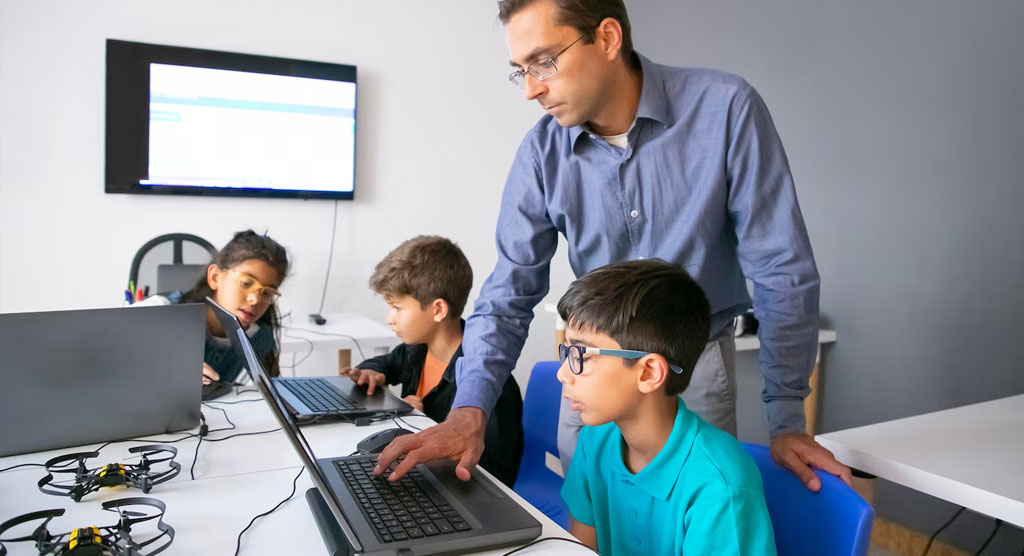Dr. R Gopal, Ex-Director, HOD & Former Dean, DY Patil Deemed to be University School of Management
Dr. Priya Vij, Associate Professor, DY Patil Deemed to be University School of Management
Artificial Intelligence (AI) has been changing the world rapidly in the recent years. Education is the highest potential field where the impact of AI is already visible and increasing. The use of AI can be seen in education and is altering the old and traditional ways of teaching, leading to a personalized, efficient, and accessible mode of learning for students all over the world. By incorporating AI tools, educational institutions and educators can provide customized experiences, execute administrative tasks with the help of robots, and enhance the student’s learning through new technologies that provides them with the necessary skills for the future.
Personalized learning is one of the most important benefits that AI can offer in education. In one place, different students with various learning styles, abilities and different levels of prior knowledge enter the classroom to get the guidance from the teacher. AI is a great tool for this. The adaptive systems that it provides can be used here. These systems look at a student’s performance and provide content that can be suited for them. Thus, platforms such as Khan Academy, Duolingo, and Coursera employ AI algorithms that modulate the complexity of tasks, suggest materials, and give instant feedback. Hence, a student can get the instruction according to their learning speed, allowing them to devote time to the weaker areas rather than focusing on the stronger area
AI is also active in automating administrative tasks by which teachers are left with more time for student involvement and imaginative teaching. Teachers can now use AI tools to perform tasks like grading quizzes, keeping records, tracking attendance, and answering frequent questions. In addition, AI can also handle the significant activity of keeping quizzes and also handle the subject of missing persons. As a result, it cuts workload on teachers and at the same time diminishes guesswork that may arise when people are doing record-keeping; thus, it ensures the accuracy and efficiency of the educational process.
Additionally, AI significantly improves the educational system by removing barriers for locals with disabilities and rural learners. AI-based speech recognition and text-to-speech tools can make the students who have visual or hearing impairments feel more comfortable by translating the words into audio and providing real-time captioning. In addition, AI also enables virtual classrooms and online tutoring, thus allowing students from rural areas to access high-quality education resources that were not available to them before.
A highly notable achievement of AI is the AI-enhanced intelligent tutoring systems (ITS) generation. These tools can create a virtual tutor’s guidance, which after screening the student’s learning needs, targets the weaknesses of the student by offering support that is most appealing to him or her. On top of that, AI acts as the way to make decisions by using the data in the case of educators who rely on data-driven decisions. AI-based apps may collect and process student assessments, course participation, and behavioral data to make predictions about students and to identify those students who will fail accurately. One way this information from the models can be used is that teachers can reach out to and assist students who are at risk. They can help the students to do well and give them something they would like to choose for themselves. This type of early intervention can be a very powerful way not only to decrease the number of student dropouts but also to increase the overall academic performance.
Additionally, AI can transform the way educational content is created and delivered with the help of Natural Language Processing (NLP) and machine learning. AI can auto-generate quizzes, flashcards, summaries, and even whole lesson plans from books, publications, or even speeches. AI also allows educational content to be easily translated into multiple languages, making it available and understandable for a global audience without language barriers.
Moreover, AI is also a powerful force in the immersive learning field through the use of tools like VR (Virtual Reality) and AR (Augmented Reality). AI can facilitate VR applications that are tailor-made for student learning thus giving students the opportunity to explore deep-seated problems of science, engineering and history. This is beyond the usual classroom practice, where experiments become the chief strategy to enhance the students’ understanding and ensure the knowledge stays by making reading on priority.
Teachers are not only responsible for imparting knowledge to students but also act as their ‘guides’, ‘friends’, and ‘helpers.’ Hence, a mixture of man’s and the machine’s power makes the future of learning sustainable.
To wrap up, the adoption of AI in the field of education is a big step forward in the reformation of the school system, leading to more efficient learning and teaching methods to students and teachers. From personalized learning paths and intelligent tutoring systems to automated administration and improved accessibility, AI is fit to handle many of the major challenges in the education system. However, it is necessary that AI is used in a careful and ethical manner




